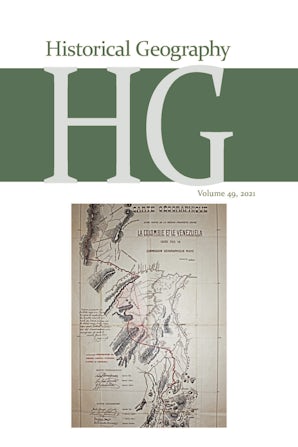
Volume 49 (2021)
This issue is printed on demand. Expect shipping delays.
Contents
From the Editors
Research Articles
Andrew Clark’s The Invasion of New Zealand by People, Plants and Animals in Review
Michael Roche
Aerial Vision and Violence: The Beginnings of Aerial Photography in Colombia (1920s)
Sven Schuster
German Immigrant Labor in Baltimore on the Eve of the Civil War
James M. Smith
Review Essay
The SAGE Handbook of Historical Geography by Mona Domosh, Michael Heffernan, and Charles W. J. Withers, editors
Robert Rundstrom
Book Reviews
Paper Trails: The US Post and the Making of the American West by Cameron Blevins
Jesse R. Andrews
Safari Nation: A Social History of the Kruger National Park by Jacob S. T. Dlamini
Stefan Norgaard
West Germany and the Iron Curtain: Environment, Economy, and Culture in the Borderlands by Astrid Eckert
Kristin Poling
Where Caciques and Mapmakers Met: Border Making in Eighteenth-Century South America by Jeffrey A. Erbig Jr.
Timothy B. Norris
Structures of the Earth: Metageographies of Early Medieval China by D. Jonathan Felt
Hieu Phung
The Historical Geography of Croatia: Territorial Change and Cultural Landscapes by Borna Fuerst-Bjeliš and Nikola Glamuzina
David S. Hardin
The Nutmeg’s Curse: Parables for a Planet in Crisis by Amitav Ghosh
Michael Kimaid
A Queer New York: Geographies of Lesbians, Dykes, and Queers by Jen Jack Gieseking
Cyd Sturgess
English Landscapes and Identities: Investigating Landscape Change from 1500 BC to AD 1086 by Chris Gosden, Chris Green, and the EngLaId Team
Hans Renes
Settler Colonial City: Racism and Inequity in Postwar Minneapolis by David Hugill
Sarah E. Nelson
Shifting Baselines in the Chesapeake Bay: An Environmental History by Victor S. Kennedy
Geoffrey L. Buckley
Confederate Exodus: Social and Environmental Forces in the Migration of U.S. Southerners to Brazil by Alan P. Marcus
Kent Mathewson
Fermented Landscapes: Lively Processes of Socio-environmental Transformation by Colleen C. Myles, editor
Romário S. Basílio
Wetlands in a Dry Land: More-than-Human Histories of Australia’s Murray-Darling Basin by Emily O’Gorman
Ria Mukerji
Spanish New Orleans: An Imperial City on the American Periphery, 1766–1803 by John Eugene Rodriguez
Dean Sinclair
The Ocean Reader: History, Culture, Politics by Eric Paul Roorda, editor
Stanley D. Brunn
Taking the Land to Make the City: A Bicoastal History of North America by Mary P. Ryan
Steven L. Driever
Iconic Planned Communities and the Challenge of Change by Mary Corbin Sies, Isabelle Gournay, and Robert Freestone, editors
Nathan Burtch
Historical Geography, GIScience, and Textual Analysis: Landscapes of Time and Place by Charles Travis, Francis Ludlow, and Ferenc Gyuris, editors
Zef Segal
The Singer’s Needle: An Undisciplined History of Panama by Ezer Vierba
Marcos Pérez Cañizares
Time in Maps: From the Age of Discovery to Our Digital Era by Kären Wigen and Caroline Winterer, editors
Dudley B. Bonsal
Trending Articles - Summer 2021
"Canadian Urban Planning at 150" (Vol. 45, 2017)
"The Ties of Historical Geography and Critical Indigenous Studies" (Vol. 46, 2018)
"Astronomical Fieldwork and the Spaces of Relativity: The Historical Geographies of the 1919 British Eclipse Expeditions to Príncipe and Brazil" (Vol. 46, 2018)
"Mary Prince, Enslavement, Cavendish, and Historic Timber" (Vol. 46, 2018)
"Historical Geographies of Interdisciplinarity: McGill University's Caribbean Project" (Vol. 46, 2018)
Check out this list of peer-reviewed articles focusing on Critical Theory, Environmental Ethics, Economics & Business, and other areas of study on Climate Change.
Reading List: Latin American StudiesArticles on a variety of topics related to the field of Latin American Studies.
Historical Geography Volumes 28 through 44 (2000 - 2016) are available as open access issues in this archive. (More recent issues are available on Project MUSE.)
Advertise in Historical Geography TodayClick the link above to view this journal's advertising rates & options!
Libraries face a dilemma: the number of books, journals, and other information resources available to offer to their patrons is growing faster than their acquisitions budgets. Decisions about which new materials to add in a given year are influenced by a number of factors, not the least of which are whether they are aware of the existence of a resource and the value that resource would bring to those who rely on the library. Librarians often appreciate the input of users in gathering the information they need to make those evaluations. There is no one right way to share information about a particular journal with a library. Some institutions have formal procedures for submitting acquisition requests, others rely on regular communication between subject area librarians and the departments they serve, and some have no specifically defined method. You are in the best position to determine the most appropriate method for approaching your library with a request for the addition of a journal to its collection. However, we have developed a library recommendation form as one tool you can use to provide your library with relevant information. The form contains basic information about the journal: a description, its print and electronic ISSNs, frequency of publication, pricing, print and electronic options, and ordering information. It also includes a few questions for you to complete that address your evaluation of the journal's value. If you choose to use the form, fill it out then send it to the appropriate individual at your library. Do not return it to the University of Nebraska Press.